Malawi is a landlocked country in Southeast Africa, known for its stunning scenery, diverse wildlife, and friendly people. It is often referred to as the “warm heart of Africa” due to its welcoming people and beautiful landscapes.
We enjoyed everything here! To visit Malawi we enjoyed everything from the incredible big 5 preserves of Liwonde National Park and Majete Wildlife Sanctuary to the majestic Mount Mulanje to the crystal-clear waters of Lake Malawi and Cape Maclear to the tea plantations of Thyolo. Malawi tourism has something for everyone to enjoy in this beautiful country!
In addition, in this Malawi travel guide we share all the logistics of Malawi travel, from things to do in Malawi to how to get here, best time to go and how to get the visa.
Getting to Visit Malawi
The easiest and most direct way to reach Malawi is to fly to Jo’burg (Johannesburg in South Africa). From North America most flights go through Europe to Jo’burg and then connect through to one of Malawi’s two ‘gateway’ airports with Airlink to Lilongwe or Blantyre.
As of 2023 Airlink operates three times a week from Jo’burg to Lilongwe on a Monday, Wednesday and Friday and into Blantyre on a Tuesday, Thursday and Sunday.
Another alternative is Ethiopian Airlines flying via Addis Ababa to either Lilongwe or Blantyre.
Best Time to Go for Malawi Travel
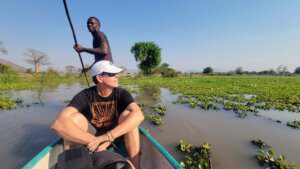
The best time to visit Malawi is during the drier months from early May to late October. This is a cooler time of year with sunny days, pleasant evenings, and perfect temperatures. October is a wonderful time to come as the weather is very dry and it is the shoulder season, meaning that many accommodations have few tourists.
Temperatures start to rise in September and remain in the high twenties and early thirties throughout the rainy season, which runs from November to April. The heaviest rains are often in December, January and February. Because of Malawi’s varied landscape, regional variations in weather are significant.
If you come for the National Parks and the game drives to see the animals, then August to October is the best time to visit Malawi.
eVisa and Visa on Arrival for Malawi Travel
Effective September 13th, 2022, citizens of Belgium, Norway, Sweden and the United States are able to receive a Visa on Arrival. However, not all airlines know this, therefore it is still recommended to apply for the eVisa prior to your Malawi travel.
The eVisa can be applied for here.
Connectivity SIM Cards for Malawi Travel
As always, we tried to pre-buy an eSim prior to landing in Blantyre. Unfortunately, it did not work. Therefore we purchased a SIM card when we arrived at the airport.
Outside of the airport in Blantyre, there are a number of different kiosks to purchase a SIM card. There are 2 options: Airtel and TNM.
Since our goal was to travel to various rural destinations in the country we were advised to purchase the Airtel SIM card. Airtel is slightly more expensive than TNM. However, at $7 USD for the SIM with 9.5 gb of data (7 days), we thought it was a good option. We had to purchase another 7 day plan once the first week was done.
Many of the lodges that claimed to have WIFI did not, so we were very happy that we got the data plan. In addition, it was easy to top up once we used up the data.
Note that connectivity in the country is sporadic and unpredictable. Especially in the rural areas of the parks. Median fixed internet connection speeds in 2023 are 8.77 Mbps. However, in reality we experienced much slower speeds.
Safety and Money
Safety
Malawi travel is relatively safe. However, one must always exercise caution and be sensible. Walking around the capital or Blantyre at night is not advisable (just like most large cities worldwide).
In addition, the people of Malawi are known for their hospitality and are always happy to help visitors. Every single time we needed something, or had trouble with our rental car (3 blown tires), people just appeared and were very happy to help.
Money
Malawi is a country that desperately needs foreign currency, specifically USD or Euros. They are very happy to accept USD for everything.
However, if you do not want to walk around with thousands of dollars in your pockets, ATMs are abundant in the larger cities. I was successful in taking out 100,000 Kwacha (approxiametly $87 USD) multiple times per day from the same bank machine in Blantyre and in Liwonde.
Note, that you may be asked at the airport if you have any foreign currency. This is the statement from the US State Department about currency:
“You must declare all foreign currency when entering Malawi regardless of the amount and exchange foreign currency at a bank or approved foreign exchange bureaus. Any currency declared at entry may be expatriated without further authorization. With bank approval, you may export up to $5,000 per trip.”
We have heard of people “losing” some of their foreign currency in customs. Therefore some travelers do hide foreign currency upon entry and exit from the country.
Car Rental, Roads, Petrol and Speeding Tickets
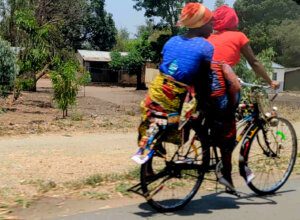
Car Rental – Malawi Travel
Prior to coming to the country, we rented our car from Flexways Car Rental Blantyre. The actual car (which was part of the problem – bald tires) was from Ana’s Car Rental. Flexways was the middleman. However, Flexways was very responsive on Whats App and did get our tires fixed quite quickly. Next time if we follow our own pro tips, we may consider renting from Flexways again.
PRO TIPS:
- Make sure to get a Whats App number from whomever you rent the car from. (We had 3 flat tires and were driving very carefully). If there is a problem, the rental car company can wire money to the tire shop or mechanic, so you do not have to pay.
- Check all the tires to make sure that they are all operable. We checked the 2 front tires. The back ones were thread bar.
- Double check that you have all the necessary equipment to change a flat, because most likely you will need to.
- The country is left hand drive, so if that is foreign to you, try to rent an automatic as shifting with your left hand may be awkward. It was fine for Rob. However, if I had to do it, we would not have gotten anywhere.
Roads
The roads are mostly paved and passable. Of course there are pot holes and some dirt roads especially in the parks. However, the roads in Malawi are much better than the ones in Mozambique and have greatly improved in the last few years.
Petrol
This country has been going through a fuel crisis for over a decade. This is due to the lack of foreign currency. Therefore at times there are long lines for either gasoline or diesel or both.
During our journey, our rental car was delayed for over an hour to pick us up from the airport (without any communication to us). All due to waiting in a long queue for petrol.
We heard from other locals and travelers that at times they waited over 8 hours in a line only to be told that the gas had run out.
However, within about a week of our travel here, some money was infused into the country by the IMF. And the lines for petrol got smaller. We were even able to pick up a full tank of gas with zero queue coming down from Cape Maclear.
PRO TIP: Keep vigilant about the fuel crisis and check if diesel is more readily available at the time that you arrive. If that is the case, try to rent a vehicle that runs on diesel.
Speeding Tickets
Traffic police are on the main roads and do stop anyone speeding. The fine ranges between $9 USD – $40 USD, depending on the speed. We were charged 10K Kwacha (which is about $9 USD) for going 70 kph in a 60 kph zone. Here are the speed limits:
- Urban: Sometimes 50 kph or 60 kph
- Rural: 80 kph
- Highway: 120 kph
6 Reasons to Visit Malawi
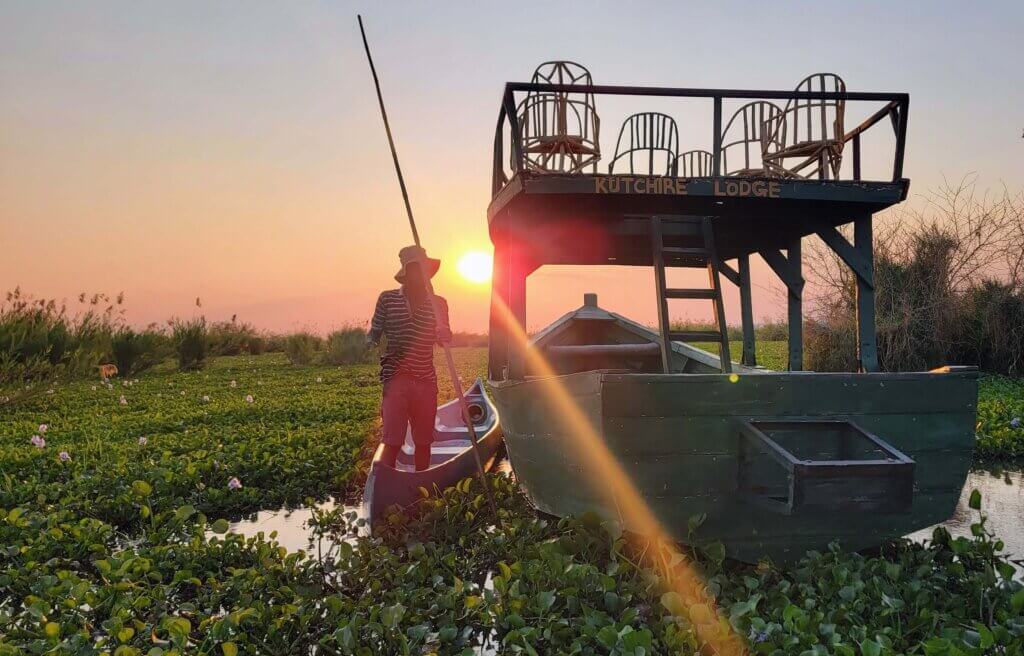
There are so many reasons to visit Malawi! It is truly the heart of Africa with some of the loveliest, most helpful and welcoming people.
The diverse topography of this country is another reason to visit. Even though geographically it is not a big place, the landscape changes quite quickly, offering a totally different view.
Here are our favorite things to do in Malawi. And we know that we will be back to see the rest of this stunning country soon.
1. Liwonde National Park
Liwonde National Park is one of Malawi’s most popular tourist destinations, and for good reason. The park is home to a variety of wildlife, including elephants, lions, leopards, cheetahs, hyenas, rhinos, and hippos. You can also see a variety of birds, including the iconic African fish eagle.
Since 2015, African Parks has transformed Liwonde National Park into a sanctuary for Malawi’s wildlife, removing tens of thousands of wire snares, establishing effective conservation law enforcement measures, and orchestrating historic animal re-introductions, including cheetah, lions, wild dogs, and black rhino. With the wildlife populations on the rise, Liwonde National Park has been restored to a safe haven for both wildlife and people.
Self drives are amazing, and for 2 foreign people and a car, the cost was 74K Kwacha (which at time of writing is about $64 USD). And you can stay for the whole day if you so wish or come in the morning and come back later in the day for no extra fee.
On our self drives we saw, lions, hippos, elephants, wart hogs, water bucks, impalas, etc., This place is truly wonderful!
2. Kutchire Lodge
In our minds the Kutchire Lodge can be the #1 attraction in Malawi! It is a lodge which is run by the locals and is located right inside the Liwonde National Park. Therefore on one hand it is an accommodation for the park, yet on the other it is the park itself.
As mentioned before, this Lodge is located inside the park and across the small river where you drive to see the animals. Therefore, while staying in the Lodge we were in the same area where the elephants, cheetahs, water buffalos, hyenas, etc., roam.
We stayed in the Stone House right on the river and watched so many animals right from our porch. In the morning, it was usually the elephant show. We would watch them eating just a meter from our mesh “windows”. It was magical!
Funny story. When we arrived at the lodge, we carefully placed all of our belongs in our Stone House and rushed to sit on the river to watch the animals. Within a few minutes we heard some noises and looked back at our terrace. Stupidly, we had forgotten a large zip-lock of teas, coffee and some spices on our terrace table.
Rob had spied a baboon running away with our bag. During his thievery the baboon bit into one of the small packets of hot sauce which was also in the bag. Poor thing, he dropped everything and ran off (probably with his tongue on fire).
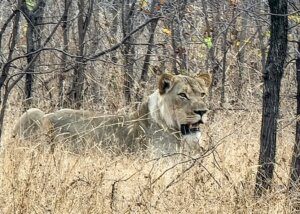
For 100K Kwecha (about $87 USD), we had our house and 3 meals per day. The house has a queen bed and two smaller beds, each with mosquito netting. The huge windows are made of wire mesh to keep the animals out and the wind blowing inside (when there is wind). Inside the house, there is a private bathroom with a shower. The room has electricity and a large terrace overlooking the river. Kutchire Lodge has many options for accommodations, mostly along the river, including tree houses.
In the morning we would wake up to excellent fresh pressed coffee, tea and toast which are provided at 5:00. This is followed by a game drive for about 3 hours and then a full delicious breakfast. I was given great vegan options, as well.
Lunch comes around mid day, with tables set near the river for the best viewing of the animals coming in for a drink.
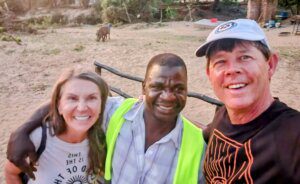
In the evenings, there is a buffet spread for all to enjoy. A large fire burns with comfortable seating around it, while Petro looks for animals that are grazing around the grounds. He loves to show them off with his flashlight to the guests. After dinner and the fire conversations with fellow travelers and staff, a staff member always escorts you to your accommodations (just in case a predator is waiting for you in the bushes).
The Lodge also provides morning and afternoon safaris on land, and a water safari at 15:00. The park does not charge park fees for the water safari. However you do pay park fees when entering the park with the Lodge safari. It works out to be about $25 USD per person (for the safari) and about $30 USD per person for the park (which is valid for the whole day).
The guides know where to find the big game -like lions, so they try to get to them. However there are no guarantees given. We need to remember that these are wild animals in their habitat. Thankfully they roam as they please. We were very lucky, though to see lions on all of our drives through the park.
We enjoyed this lodge so much, that we returned to it for one more night on our way down to Majete from Cape Maclear. And we are so glad that we did!
3. Lake Malawi and Cape Maclear
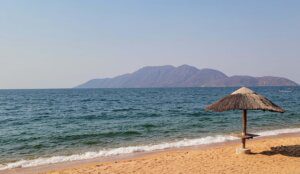
Lake Malawi is the ninth largest lake in the world, and it is home to over 1,000 species of fish. The lake is a popular spot for swimming, snorkeling, and diving.
We really enjoyed visiting Cape Maclear, a beautiful peninsula on the southern shore of Lake Malawi. Cape Maclear is known for its stunning beaches, crystal-clear waters, and laid-back atmosphere. The sense of community in the fishing village of Cape Maclear is palpable. We felt incredibly welcomed and grateful to be part of this lovely place.
On our walks through the village, small children would literally run up to me and hug me. These hugs were full of genuine joy. These kids didn’t want anything, didn’t ask for anything – just wanted to say hello and give a hug. I will carry those joyous embraces with me for the rest of my life!
Activiities Cape Maclear

There are no shortage of activities at Cape Maclear! Each accommodation has a group of tour operators who will be waiting for you to choose an activity. There are a multitude of options for water activities from boat rides to islands, snorkeling trips to diving trips.
In addition, there are hiking opportunities in the area as well. The activity that we can highly recommend is the trip on the boat called the Sundowner.
The trip starts from your hotel on a wooden boat (which has a cover for sun protection) sometime between 14:30 and 15:00. The boat will go towards Thumbi Island where you will have the option to snorkel with hundreds of fish. These fish have vibrant colors ranging from light blue to sunny yellow.
Then the captain of the boat will continue along the west side of Thumbi island, calling to the Fish Eagles. And yes, each bird has a name! The captain will then throw a fish in the water and the eagles will fly to collect their prize.
After the unusual bird watching experience we enjoyed the sun set over Otter Point in the waters of Lake Malawi National Park. And as the sun dropped behind Thumbi Island, the boat returned to our hotel.
PRO TIP: Prices for the various activities on the lake vary greatly. We were staying at Tranquilo Lodge and were offered the Sundowner for $50 USD per person. However, when we walked over to have lunch at Mgoza Lodge, our friends were leaving for the Sundowner for only $25 USD per person.
Accommodations Cape Maclear
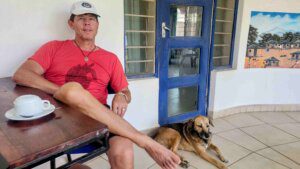
There are a myriad of accommodation options in Cape Maclear. Our favorites are below:
- Mgoza Lodge: This lodge is located right on the lake and has a fun vibe. Mgoza Lodge offers accommodation to suit all budgets, including frame thatched dorms, private huts, uniquely decorated en suite chalets, and a self catering cottage. There is no air conditioning and only paid wifi. However the restaurant is one of the best in the village and offers options for both vegans and vegetarians. Prices depend on the time of the year, but during our stay were $100 USD per night.
- Tranquilo Resorts: Although this place does not have the best rating, we loved it! The rooms are clean and large. There is hot water and air conditioning. Our king bed was comfortable and we had a kitchen. Our porch had a table and chairs overlooking the beach and the small pool. In addition, there was free secure parking for the full tank of gas in our car. Our favorite part of this lodge was that it came with Snowy and Muffin. Two lovely and gentle dogs who kept the monkeys away and were always there for a scruff. All this with breakfast for $40 USD per night.
4. Majete Wildlife Sanctuary
Majete Wildlife Sanctuary is a former hunting reserve that has been transformed into a wildlife sanctuary. The sanctuary is home to a variety of wildlife, including lions, elephants, rhinos, and leopards. You can also see a variety of birds, including the endangered black rhino.

Majete is the only reserve in Malawi where you can see the majestic giraffe and African wild dog. It also has the highest concentration of predators in the country, including hyena, cheetah, leopard, and lion. Your chances of seeing one of these big guys is very good indeed.
All funds generated in Majete contribute towards the management of the reserve. So by visiting Majete, you’re not only having an amazing wildlife experience, but you’re also helping to protect this precious place for future generations.
Game drives are available twice a day: 6:00 – 9:00 or at 16:00-19:00. Alternatively you can self drive the park. Fees for international travelers are $30 USD per person + the vehicle.
Accommodations of Majete Wildlife Sanctuary
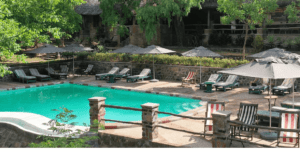
There are a number of options in Majete for accommodations. However, you must decide if you want to be in the park. Or if by now, you are looking for a bit of luxury in the form of air conditioning. Oddly, the more luxurious Ngona Lodge is much cheaper than the Thawale Camp (which is located inside the park).
Here are our suggestions:
- Ngona Lodge: This lodge is an oasis in the African bush. It is set in a tranquil environment on the banks of the Shire River which flows out of Lake Malawi, south to join the Zambezi River in Mozambique. Although the lodge is not in the park, it is located just 1.5 km from it and is a fantastic retreat. The chalets have air conditioning, there is a refreshing pool and delicious food.
- Thawale Camp: This camp is located inside the Majete Wildlife Sanctuary. So, it is a lot like our beloved Kutchire Lodge. However, at a much higher price tag. Like Kutchire, it is set on the edge of a pristine waterhole that regularly attracts a wide variety of wildlife, including a family of elephants that often frequent the area. Within the reserve boundaries, the lodge is completely un-fenced to give guests a unique experience in the natural surroundings. The lodge does not accommodate children under 3. Here is a pdf brochure of the camp.
5. Mount Mulanje

Mulanje is Malawi’s highest mountain, and its scale is truly awe-inspiring. Its bare rock flanks tower to 10,000 feet (3,000 meters), dwarfing everything around it. Mulanje is actually a massif of syenite and granite covering a massive 650 square kilometers.
Erosion by rivers has created deep clefts that strike back into the heart of the mountain, where cauldron-like hollows have developed. The resulting landscape is a wondrously beautiful one of basins, plateaus, rivers, gorges, waterfalls, and no less than 20 peaks above 2,500 meters.
To experience this mountain there are quite a few options. One is to drive around the large chunk of rock. However, the better choice is to hike some of the trails that the mountain has to offer. Trekking times range between just a few hours to multiple day trips. The Mountain Club of Malawi has created some great options here.
Visitors can spend a couple of hours taking a walk to some river pools and waterfalls, or spend many days exploring the whole massif. In addition, arrangement can be made to hire camping equipment and the services of guides. Here is a Whats App number for one of those guides: Madalitso +265 884 06 38 87 (he is also a driver).
Accommodations of Mulanje
Mulanje town, is at the base of the mountain. It has shops and services as well as a colonial ‘sports club’ (complete with golf course) and a few hotels, lodges and guest houses. Our favorite accommodation here is the Africa Wild Truck Camp & Lodge, which offers a variety of accommodations in a converted colonial building. They can also organize hikes on Mount Mulanje, using local guides and porters.
Africa Wild Truck Camp and Lodge in Mulanje is an eco-friendy lodge and camp located about one hour’s drive from Blantyre International Airport. You can also get here from Mozambique, as this lodge is just 6 km from the Muloza-Milange border post.
There are rooms and camping/dorm options. There is also a bar and an Italian Restaurant for the guests. This is an ideal place to share travel experiences and an evening at the fireplace!
6. Tea Plantations of Thyolo

Nestled between the bustling city of Blantyre and the majestic Mount Mulanje, lie the Thyolo Tea Estates. This idyllic region has been producing world-class tea since 1908, and it’s manicured bushes and lush greenery create a lovely landscape.
The Satemwa Tea & Coffee Estate is perhaps the most popular of the Thyolo Tea Estates, and its intriguing history dates back a century. The estate was first purchased by Scottish tea planter Maclean Kay in the 1920s, and his son Robert, known as “Chip,” soon took over and developed it into the thriving operation it is today. Chip is still around in his 90s, and he loves to share stories about the estate’s early days.
Satemwa offers tea tasting sessions where guests can visit the factory to learn about the tea growing process and sample a variety of teas. The tasting sessions are informative and enjoyable, and they’re a great way to learn about the different flavors and aromas of tea.
And since 1971 this estate has also been producing coffee. We highly recommend visiting this or any of the other estates in Thyolo to get a taste of their amazing teas.
In addition, the Thyolo Tea Estates offer more than just tea and coffee. The Thyolo Forest Reserve is a haven for walkers and birdwatchers, and it’s also a great place to go for a bike ride.
Accommodations of Thyolo
In Thyolo you have a few options. However, these are our favorite ones:
- Huntingdon House: A 1928 colonial family home (Maclean Kay family) with 5 suites and a free standing bungalow called the Chawani Bungalow. Both of these are set on the Satemwa Tea Estate and are much more luxurious than our favorite Kutchire Lodge.
- Game Haven Lodge: This posh lodge is set in the private Chimweyna Game Park on Thyolo Road. This Lodge is closer to Blantyre and a bit farther from the plantations. Here you have the option of visiting a private game park to see the animals and also be close enough to visit the tea plantations.
Wrap Up- Malawi Travel Guide

Malawi travel totally surpassed all of our expectations. The people make this land warm and incredibly hospitable.
The diversity of the terrain made us wonder, where are we?! From the amazing animal parks of Liwonde and Majete to the lushness and sandy beaches of Cape Maclear. Not to mention, the beauty of Mount Mulanje and the Thyolo Tea Plantations. There is just so so much to see and experience here!
In addition, we felt safe in Malawi. Accommodations and food were basic yet delicious. Most people spoke English, so we did not experience a language barrier.
This is a country that we will definitely return to! We hope that this Malawi Travel Guide has helped you travel Malawi.
Have you ever considered Malawi travel? Have you been to this amazing country? What did you enjoy the most? Let us know in the comments section if you have any questions. We always love to help fellow travelers make their journeys more enjoyable.

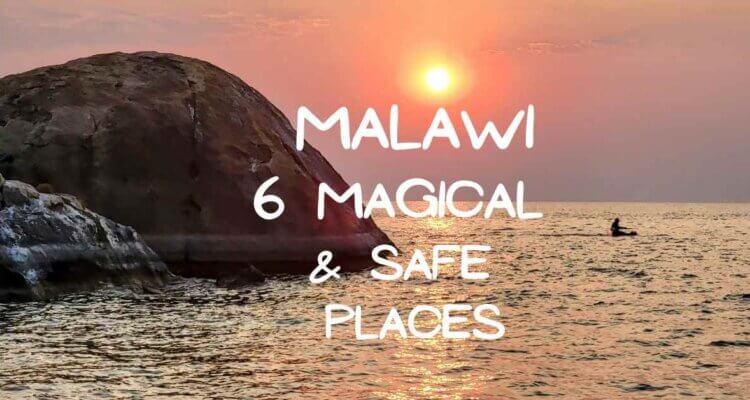
2 Comments
Wonderful place to visit. Really enjoyed your blog. You both look
fantastic! What a Life eh!! Love from Lynda Nielsen
Thank you so much Lynda! We are very grateful for how we get to live our life and hopefully help some people along the way! Thank you for reading. Hugs to you!